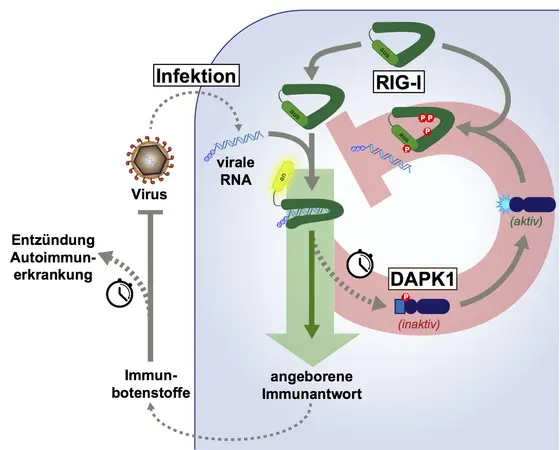If viruses such as influenza or Hepatitis C viruses infect a cell, the innate immune system of the human body reacts immediately: It releases chemical messengers which alert the surrounding cells, trigger an inflammatory response and activate the adaptive immune system. Heidelberg researchers have now discovered a mechanism that eventually inhibits the defensive response and therefore prevents long term cell damage and possible autoimmune diseases: A sensor for infections with so-called RNA-viruses is the receptor RIG-I (retinoic acid inducible gene I), which recognizes the genome of the virus according to its specific structure, then binds with it and triggers defensive reactions to it. About 8 hours after the infection, RIG-I triggers its own adversary: DAPK1 (death associated protein kinase 1), an already familiar enzyme, which – as the name suggests – functions destructively. The enzyme deactivates RIG-I, so it cannot recognize RNA-viruses any longer. The defense is inhibited. Dr. Marco Binder – former fellow of the Medical Faculty of Heidelberg at the Center for Infectiology and current leader of a research group at the DKFZ – published the results of his research group in the journal “Molecular Cell.“
Interestingly, this regulatory mechanism has a timer of sorts, which ensures that the RIG-I can initially lead the defense against the viruses without being inhibited. Using influenza viruses which infect human cells, this current study showed that DAPK1 only became activated about 8 hours after the initial infection. “As soon as DAPK1 is fully active, we see how the antiviral defense program is slowly shut down. In the course of our research, we were able to show that this was not just a random correlation, but rather that the two are causally linked,“ said Dr. Marco Binder. Without this kind of counter-regulation of the body, there could be an excessive release of chemical messengers by the immune system, which could lead to cell damaging inflammation and long term auto immune diseases.
Hepatitis C Infection and Liver Cancer: DAPK1 could facilitate Tumor Growth
These new findings may help indicate why a chronic infection with Hepatitis C viruses leads to liver cancer for some patients. Hepatitis C viruses are able to trick the body's immune system and permanently settle in liver cells. The sensor RIG-I stays active throughout and could in this way permanently activate DAPK1. “Current studies show that with certain very aggressive tumors an activation of DAPK1 greatly facilitates tumor growth,“ summarized Dr. Marco Binder. “If, during a chronic Hepatitis C infection, the constant, latent activation of DAPK1 coincides with a specific genetic defect, then it is as if one adds fuel to the fire.“ In the future, researchers want to clarify whether there might be a correlation with a defect in the p53 gene - also known as the “guardian of the genome“ - which is responsible for repairing DNA.
The Heidelberg researchers achieved their discovery by deactivating all 719 known human kinase genes in human cell cultures one after another. They then noted that the kinase DAPK1 measurably slows down the cell's program by transferring a phosphate group to RIG-I. The phosphorylation deactivates the RIG-I and the viruses can multiply unchecked.
Literature:
Willemsen et al. (2017): Phosphorylation-Dependent Feedback Inhibition of RIG-I by DAPK1 Identified by Kinome-wide siRNA Screening. Molecular Cell 2017. dx.doi.org/10.1016/j.molcel.2016.12.021
Further information on the internet:
http://www.dkfz.de/de/virus-assoziierte-karzinogenese/groups/AGBinder/index.html



